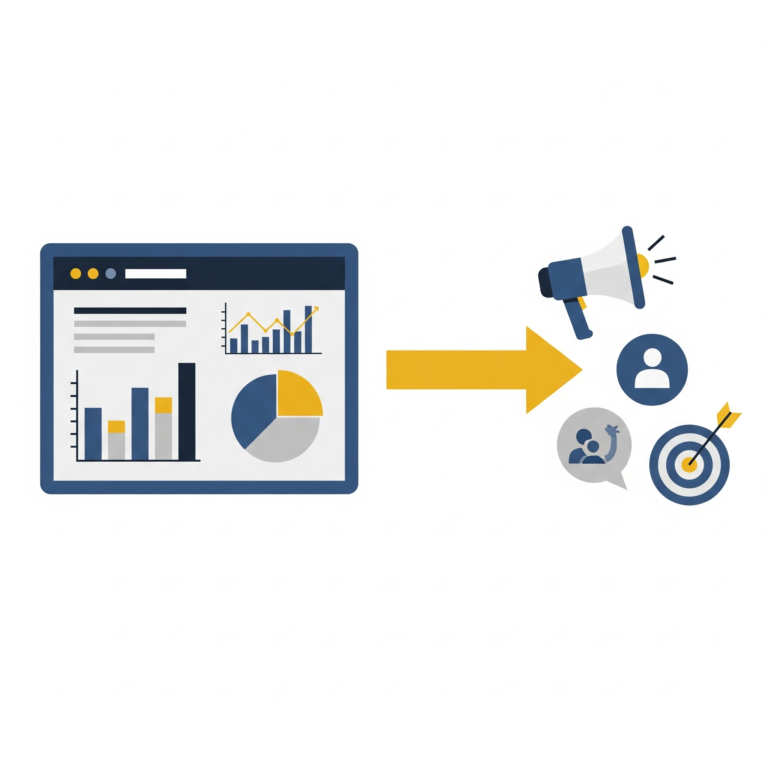
For many business owners, the marketing and finance departments feel like they exist in two different worlds. The marketing team talks about clicks, leads, and brand awareness. The finance team talks about profit margins, cash flow, and budgets. This disconnect often leads to a critical question that goes unanswered: Is our marketing actually making us money?
Spending money on marketing without a clear connection to your financial data is like driving a car with a blindfold on. You’re moving, but you have no idea if you’re heading toward a cliff or a clear road.
The most successful businesses in Bahrain and the GCC are closing this gap. They are building a data-driven feedback loop where financial insights directly inform marketing strategy. This guide will show you how to use your own financial data to stop guessing and start making marketing decisions that guarantee a better return on investment (ROI).
The Problem: “More Leads” is a Dangerous Goal
When a business decides to invest in marketing, the default goal is often “we need more leads.” While well-intentioned, this is a flawed objective. Not all leads are created equal, and not all customers are equally profitable. Chasing “more leads” without financial context can lead you to:
- Spend thousands of dinars acquiring customers for your least profitable service.
- Acquire customers who are expensive to serve and have a low lifetime value.
- Run campaigns that look successful on the surface (lots of clicks!) but do nothing to improve your bottom line.
The Solution: Connect Your Engine to Your Dashboard
The solution is to connect your marketing engine (your ads, your website, your content) to your financial dashboard (your accounting system). A modern, cloud-based system like Zoho Books is no longer just for recording transactions; it’s a goldmine of strategic data.
By analyzing this data, you can answer four critical questions that will transform your marketing strategy.
1. What is Our True Customer Acquisition Cost (CAC)?
The Question: How much does it actually cost us, on average, to win a new customer? How to Answer: This isn’t just your ad spend. It’s your total marketing and sales expenses for a period, divided by the number of new customers you acquired in that period. Your financial system has the precise expense data you need to calculate this accurately. Why it Matters: Once you know your CAC, you can instantly evaluate marketing channels. If LinkedIn ads bring you customers for BHD 50 and another channel brings them in for BHD 200, you know exactly where to allocate your budget.
2. Which of Our Services is the Most Profitable?
The Question: We know what we sell, but do we know what makes us the most money after all costs are considered? How to Answer: A system like Zoho Books can be configured to track revenue and direct costs by service line or project. This allows you to run a profitability report and see, for example, that “Service A” has a 70% profit margin while “Service B” only has a 30% margin. Why it Matters: Why would you spend your marketing budget acquiring customers for your least profitable service? This data allows you to focus your marketing firepower on attracting high-margin clients, dramatically increasing your overall profitability.
3. What is the Lifetime Value (LTV) of Our Customer?
The Question: Once we win a customer, how much revenue do they generate for us over their entire relationship with our business? How to Answer: Your financial system holds the history of every transaction from every client. By analyzing this data, you can calculate the average LTV. Why it Matters: The LTV-to-CAC ratio is one of the most important metrics in business. If your average customer is worth BHD 5,000 (LTV) and it costs you BHD 500 to acquire them (CAC), you have a very healthy 10:1 ratio. This tells you that you can confidently invest in marketing because you know you will get a strong return over time.
4. How Can We Set a Marketing Budget Based on Real Data?
The Question: How much should we actually spend on marketing next year? How to Answer: Stop picking a random number. Use your historical financial data to build a forecast. A common method is to allocate a percentage of your target revenue to marketing. For example, if your goal is BHD 500,000 in revenue and you decide to allocate 10% to marketing, you have a clear, data-backed budget of BHD 50,000. Why it Matters: This creates a predictable and scalable model for growth. As your revenue grows, so does your marketing investment, creating a sustainable growth loop.
Conclusion: Marketing is an Investment, Not an Expense
At ASM Bahrain, our philosophy is that marketing and finance are two sides of the same coin. As business consultants and Zoho experts, we don’t just build marketing campaigns; we build integrated systems where financial data provides the intelligence to create smarter, more profitable marketing strategies.
By connecting your financial insights to your marketing decisions, you transform marketing from a speculative expense into a predictable, measurable investment in your company’s future.
Ready to build a marketing strategy that is as smart as your business?
[Contact ASM Bahrain today for a free consultation to see how we can connect your financial data to your growth engine.]
Hello@asmbahrain.com
